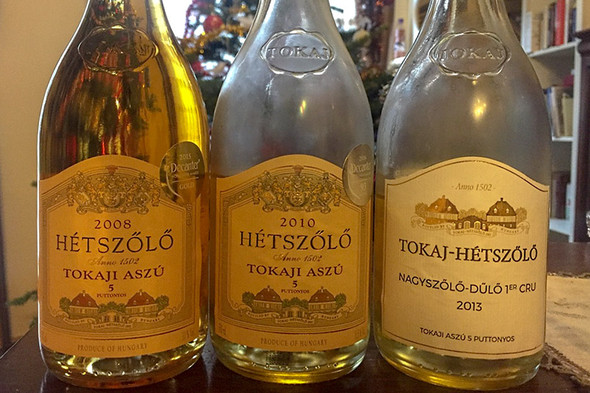Thanks to the organisers of the #koccintsaszuval (#toastwithaszu) campaign and the generosity of the Hétszőlő estate, there are three bottles of Aszú currently resting in my wine fridge, which is what the following article is all about. Wines from Béres Vineyard Estate and Barta Winery ended up on my table in previous years; now it was the turn of perhaps the most important estate in the town of Tokaj itself, Hétszőlő.
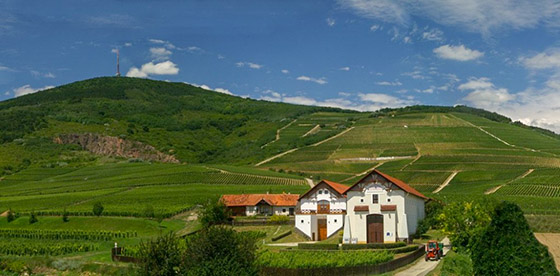
The Hétszőlő Estate from their website
But what makes an estate emblematic? On the one hand, and obviously the most important, its wines. If there is not outstanding quality for decades, then all good intentions are in vain. On the other hand, its past may also predestine this, which is also the case with Hétszőlő. The historical Mézesmál promontory was recorded in the form of Mezezmaal from 1411. Fragmentation of the vineyard hill (this is an even larger unit than the vineyard) took place over the next hundred years. As regards Hétszőlő, the most important name, however, was the gentry branch of the Garay family, who acquired significant vineyard estates on the edges of Tarcal and Tokaj. It was they who merged the seven vineyard estates they had previously purchased on the Mézesmál in 1502 and created Hétszőlő (Hethzelew). Anyone who is curious about the history of the not entirely intrigue and bloodshed-free history of the Nagyszőlő associated with Hétszőlő, should read Kornél Nagy’s brilliant account of it here. It’s a must for Tokaj fans, but it’s definitely worth a read for others too!
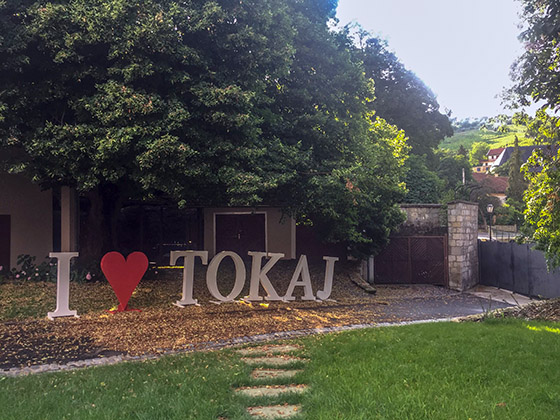
I love Tokaj (pic: Daniel Ercsey)
Tokaj’s wine history is, of course, much more complicated than can be summarised in just one article. However, its key milestones include the Turkish, Austrian and Soviet armies, the Habsburg customs, division of Poland, losing two world wars, world economic crisis, the loss of the country’s territories (commonly referred to as Trianon) and then a pleasant 45-year-long Soviet co-existence, which over about 470 years, sought to destroy one of the world’s most wonderful wine regions. Today, we can now see that they were not successful. Tokaj is coming back to life and there is every chance it will succeed, as the land and the vineyards are still there unchanged. This was recognised by some foreign investors at the time of the regime change, when the state wine cooperatives landholdings were privatised into large units of around 100 hectares, on the advice of András Bacsó. Since then, Disznókő, Oremus, Pajzos and Megyer have proved András right. These estates now all belong to the world’s front rank (along with Royal Tokaji and the subject of this article, Hetszőlő), which they would not have been able to do without relatively large estates, in Hungarian terms, and thus more cost-effective production costs.
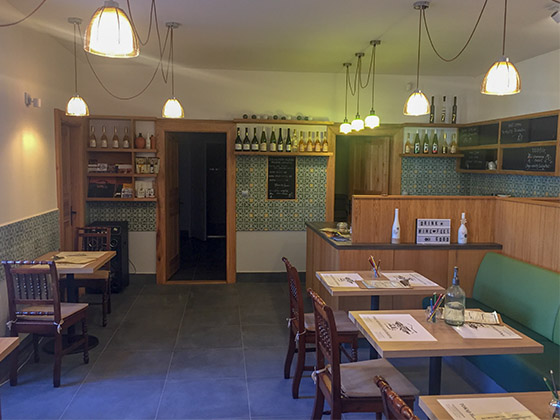
The Hétszőlő WineBar on the floor of the Rákóczi Cellar in the downtown of Tokaj (pic: Daniel Ercsey)
This is how Hétszőlő also came into being in the early nineties, thanks to French investors. The main difference, however, between the other large estates and Hétszőlő was that, while the former mainly purchased land, Hétszőlő signed a 99-year lease with the Hungarian state for the once most important part of Mézesmál between Tokaj and Tarcal, the historic Hétszőlő, Nagyszőlő, Lencsés and Kis-Garai vineyards. Anyone who starts to pull faces (as many people have done) about why they let foreign capital into Tokaj-Hegyalja, should remember that the land was fallow, overgrown with scrub and without any grape production! Hétszőlő pulled these wonderful vineyards back from the dead, built roads, renovated the four-hundred-year-old terraces, replaced the retaining walls, planted vines, built a winery, provided work and offered jobs. They not only saved the vineyards from decay, but also the former salt house on the banks of the Tisza in Tokaj, where the shipments of salt coming along the river from Maramures were once unloaded and cleared customs, before the building continued its existence as the Dessewffy family mansion. The building is now the Hétszőlő estate centre and they also plan, although only in the more distant future, that another transformation may further connect it to Hegyalja’s tourist circuit.
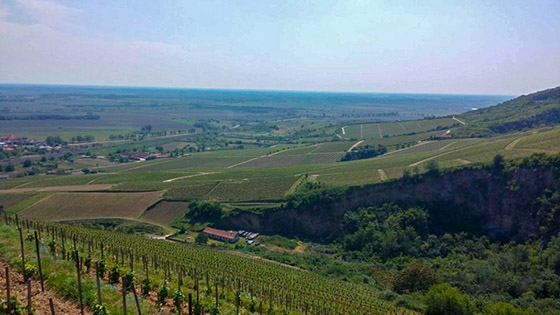
The Hétszőlő vineyards from their website
More than 25 years have passed since the investment, Sue Tolson wrote a wonderful summary about it here, which is worth reading!
There are, of course, other interesting things in Hétszőlő’s modern history! It was not so long ago that the first Aszús created by the large estates began to be rejected by the OBB (National Wine Judging Committee), saying that they did not reflect the Tokaj character, which, at that time, meant bread crust and mushroom notes and oxidative wines. Which was true. The Aszú image that had become common under communism was characterised by high acidity but heavily, often shockingly, oxidised wines, sometimes fortified, and if necessary, adjusted with concentrated must. The estates created by foreign investors producing for the global market as well as some astute Hungarian professionals quickly realised that this policy could not be successful in a wine region losing its old socialist markets and looking for new markets. Therefore, they went back to the last time when sweet wines of controlled quality were still being produced in Tokaj, which was right at the beginning of the 20th century, when nobody questioned the fact that the aszú berries were macerated in must or new wine and that following the fruit flavours, its mature character would develop in the wine after bottle ageing. These battles have now been fought; moreover, accompanying the Aszú renaissance, a new style of dry wine has also appeared in Tokaj thanks to István Szepsy, Zoltán Demeter, László Alkonyi and Anthony Hwang of Királyudvar, and late harvest wines now also have a raison d’être. The latter is linked to the then director of Hétszőlő, Tibor Kovács, who incorporated his previous experience in Alsace into his estate philosophy and into the horizons of the fractious OBB judges. I’d just like to quietly add here that one of the six varieties currently permitted in Tokaj, Kövérszőlő, which had once been cultivated here, had totally disappeared from the hillsides by the beginning of the nineties and it was also Tibor Kovács who brought it back from the Romanian Cotnari wine region, where it is the main variety for their local botrytised sweet wines, Grasa de Cotnari, to this day.
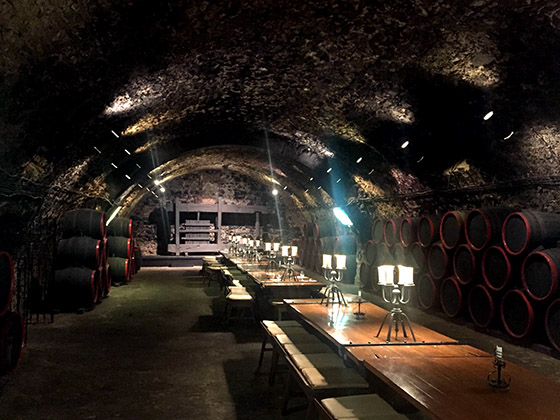
The Rákóczi Cellar in the downtown of Tokaj (pic: Daniel Ercsey)
Hétszőlő is also special today in that it is the first of the large estates to convert its entire area, that’s all 55 hectares, to organic pest control. Thus, they don’t use absorbent substances and they work organically, but what’s even more important, they undoubtedly advertise the greatness of the wine region to anyone who comes to Tokaj today with the newly magnificent old estate of Hétszőlő, the largest estate working on non-volcanic, rather loess, terroir. Thanks to this, the estate’s style is characteristically light and elegant, frequently with some floral notes.
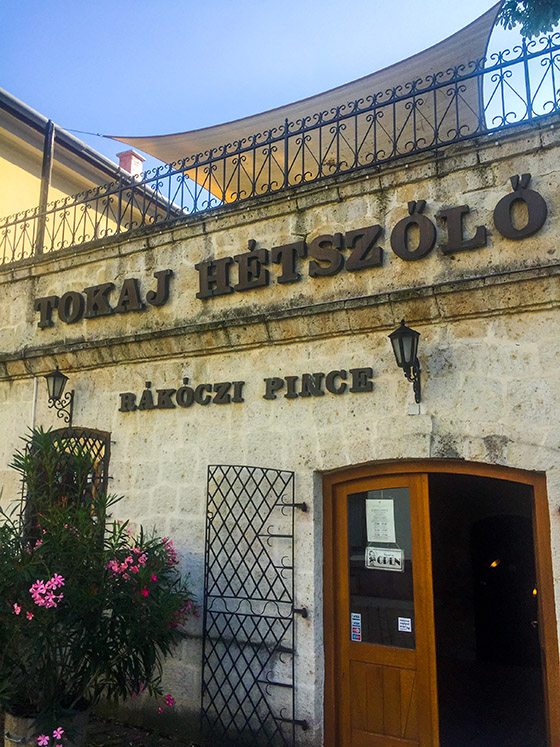
The entrance of the historic cellar in Tokaj (pic: Daniel Ercsey)
For those who have read this far, here are the tasting notes of the three Aszús, to ease the choice for your next dinner or gathering. Because the point here is not to buy an Aszú to display on the top of the kitchen cabinet, but rather to open it, show it to as many people as possible, discover its depths, in youth or old-age and, of course, to toast bygone centuries and future health!
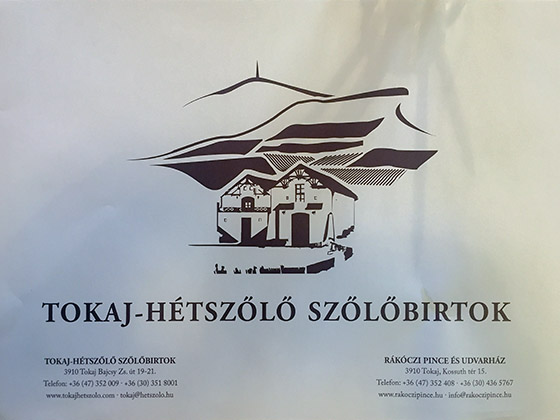
Preparing for tasting (pic: Daniel Ercsey)
Hétszőlő 5p Aszú 2013 I 94 points
Notes of coconut, mango, plenty of apricot, tropical fruit, orange, orange zest and touch of chestnut on the nose. Full-bodied, round and smooth with flavours of orange, pineapple, coconut, mandarin and vanilla. Warm Mediterranean style Aszú, unctuous and long on the finish.
Hétszőlő 5p Aszú 2010 I 93 points
Cool elegance on the nose, a little standoffish, with aromas of pear, mint, citrus fruit, white flowers, fresh grapes and white pepper. Medium body on the palate, the acidity practically scours your mouth clean and the tannins give the wine structure. Flavours of vanilla, citrus fruit, mint, green apple and a pinch of anise. The almost infinite finish is dominated by citrus fruit. Incredibly fresh Aszú.
Hétszőlő 5p Aszú 2008 I 92 points
Sweetish, candyfloss nose of overripe peach and quince with some secondary aromas developing. Mouth-filling and full-bodied with lively acidity, dried peach and apricot and ripe orange which lingers on the finish. The finish takes its leave with lovely spice, a touch of tea and slight bitterness. The tannins are nicely integrated, but the flavours are in a transitory phase. I’d wait another 2-3 years to drink this.
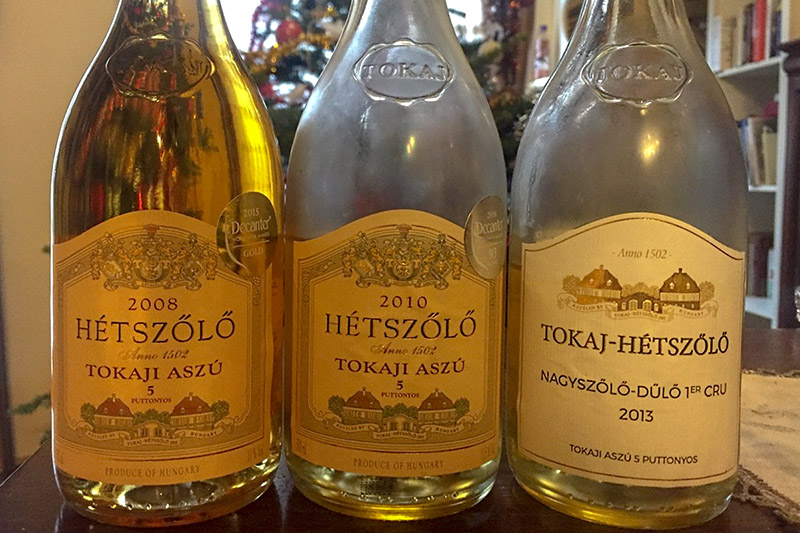
3 beautiful Hétszőlő aszú bottles (pic: Daniel Ercsey)



